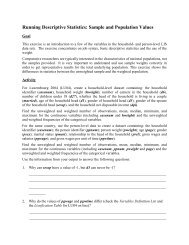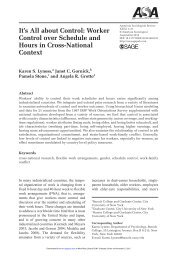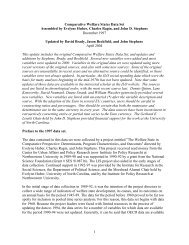Nicola Dickmann: - LIS
Nicola Dickmann: - LIS
Nicola Dickmann: - LIS
Create successful ePaper yourself
Turn your PDF publications into a flip-book with our unique Google optimized e-Paper software.
Luxembourg Income StudyWorking Paper SeriesWorking Paper No. 360Fertility and Family Income on the Move:An International Comparison Over 20 Years<strong>Nicola</strong> <strong>Dickmann</strong>October 2003Luxembourg Income Study (<strong>LIS</strong>), asbl
<strong>Nicola</strong> <strong>Dickmann</strong>:Fertility and Family income on the move– an international comparison over 20 years1 IntroductionThe income situation of families has always been a major topic for politicians and thepublic in modern welfare states. The ongoing call for better funding of families reflectsthe hardship of couples with children who seem to be unable to sustain the livingstandards of childless couples in similar circumstances. Much research has beenconducted to reveal the differences in poverty lines among families across nations andto describe the circumstances of child poverty (see for example Smeeding et al., 1999 orVleminckx, 2001). With the emerging problems of demographic change, the supposedlypoor economic situation of families is also taken into consideration as fertility rates arefalling far below replacement levels in most industrialised countries (<strong>Dickmann</strong>, 2003, p.51). In this context, children are often seen as a fundamental contribution to society andno longer treated as an entirely personal decision of couples who, therefore, have toface the consequences whatsoever. Instead, the discussion about pronatalistic policiesto foster the number of children has started and is now being made a subject not only intraditionally pro-natalistic policy nations like France but also in Germany. Hitherto suchdebates had been avoided in this country for a long time due to the horrible experiencesof racially glorified motherhood under the Nazi-regime (Schwarz, 2000, p. 431).This study aims at providing some interesting facts about the correlation of fertility andincome and on the income situation of families in order to provide a sound basis forfurther political discussions. It looks at the relative economic situation of families incomparison to childless couples so as to reveal incentive structures for couples todecide for or against children. Hereafter, investigations of different sources of familyincome try to clarify the reasons behind the observed developments over time.Furthermore, the often suggested correlation between low income and many children orhigh income and few descendants is being tested statistically in order to measure therelevance of the economic situation for the fertility decision.1
The paper is organised as follows: After explaining the methodological background ofthe selected sample and the calculation with the data of the Luxembourg Income Study(<strong>LIS</strong>), the study analyses the correlation between income and fertility. Next aninvestigation of the economic situation of families in comparison to childless couples atthe very beginning of the 1980s is being conducted and compared with the data around1990 and 2000. The paper then looks for explanation of the observed differences, first incomparing the cash benefits to families across countries over time followed by a closerlook on the development of the personal income of family members. The paper endswith a brief discussion of the political implications of the findings.2 Methodological backgroundIn order to compare living standards of families and childless couples over time it wouldbe desirable to look back at the relevant figures after the active family phase has beenterminated. However, cohort related event data is not available at international level. Thestudy therefore uses panel data from the Luxembourg Income Study to compare livingstandards across six nations at three time points. 1 As the <strong>LIS</strong> is based on national paneldata, it is not possible to compare countries in exactly the same year. For the mediumtermperspective of this study, however, this does not represent any major restriction.The paper therefore compares the data of the USA, Canada, the United Kingdom,Germany, Sweden, and Finland using the surveys around 1980, 1990, and 2000. 2All national income figures have been transformed to international dollars in order toenable a better comparability, using the purchasing power parity concept of the WorldBank (The World Bank, 2001). The reasoning behind this concept are the defaults ofexchange rates in reflecting living standards across nations, as popularly documentedby the “Big-Mac-Index” of the magazine “The Economist”. This index compares theprices of a hamburger from the fast food company MacDonald’s around the world. As1 The samples do not content the same persons but people selected at random.2 The excact elicitation years are: Germany 1981, 1989, 2000. United Kingdom 1979, 1991, 1999. UnitedStates of America 1979, 1991, 2000. Canada 1981, 1991, 1998, Sweden 1981, 1992, 2000. Finland 1987,1991, 2000. Earlier data for Finland is not available, some tests with the surveys around 1980 thereforeexclude Finland.2
the fast food chain operates internationally with a franchising system, the hamburgersare almost exactly the same in each country. Despite this, the national prices convertedinto US-Dollars at current exchange rates show astonishing differences, due to thevolatility of currencies and non-reflected short-term changes in relative prices. In order toimprove the comparability of living standards, the World Bank therefore developed theconcept of purchasing power parities, based on an evaluation of more than 100 goodsrelative to the medium price of a sample of countries (World Resource Institute, 1997,chapter 7). This concept is used here.Furthermore, a weighting factor has been applied to protect the sample from distortion.This factor restores the balance between different groups according to their originalprobability in the sample, as some groups are actually more willing to respond to theinvestigators than others. The weighting factors are provided by the <strong>LIS</strong> membercountries surveys who use certified distributions in the total population for correction. Inmost countries the weighting factor also inflates the sample to population size. To avoidfalse proves of significance, the wheighting, therefore, has not been used in this studywhen looking at statistical correlations and significance tests.In panel data there is hardly ever any information available on the final number ofchildren born to a mother. Instead, the number of children under the age of 18 living inthe parent’s household is being counted. On the one hand, this leads to major problemsin comparing families and childless couples, as every couple turns to be statisticallychildless when the children have left home to live on their own, e.g. all pensioners tendto show up as childless. A comparison without age restrictions on the sample wouldtherefore lead to severe misjudgements. On the other hand there is no theoreticallycorrect rule for setting the age lines of the sample. It proves to be quite difficult to findthe right sample and not to set the age lines too narrow and hence damaging thesignificance of the data for the population as a whole. More educated mothers tend toget their children later than less educated women (Klein, 1989, p.497). This also leads toproblems in defining the active family. A teenage pregnancy would leave the motherstatistically childless already in her late thirties, while academically educated womentend to start their family around that time. By looking at the data of the six countries in3
question, the level of childless women seems to be a good indicator for the relevantfamily phase. At the age of 30, the group of childless women, measured by the mean ofall countries, descends for the first time under the level of any other group with one ormore children. At the age of 43 it takes the lead again. The study therefore comparesthe relevant data of couples with the spouse being between the age of 30 and 42. Thesample is restricted to married couples in order to explore the economic situation of twoadults living with or without children. Hence, the often severe economic problems of lonemothers are ignored in this study. This does not indicate any underestimation of thedimension of this problem, but shall not be the focus here.3 Income and fertilityAccording to the economic theory of fertility, couples decide rationally over the numberof children they want, taking the costs of raising children and their income situation intoaccount (Becker, 1960). A higher income should primarily provide a stimulus for couplesto have more children, being able to afford the costs of raising more children thancouples in worse financial conditions (known as the income effect). On the other hand,higher income leads to higher opportunity costs, provided that both parents contribute tothe family income and one has to give up paid work in order to spend time at home,raising the children. Furthermore, according to Becker, educated parents tend to investmore in the education of their children and are therefore facing higher costs of raisingchildren (substitutional effects). Which effect dominates the other has been debatedextensively in the context of the low fertility levels in industrialised countries. Quite often,researchers say that high income couples have fewer children than low income couples,therefore giving a priority to the substitutional effect (Schwarz, 1999). This phenomenonis known as the demographic paradox (Birg, 2001, p. 42ff). However, studies, providingempirical evidence for this are hard to find. In most cases, researchers quote the highlevels of childlessness among academic women as a prove or revert to themacroeconomic evidence that rich countries have lower fertility rates than poorcountries. But neither fact indicates the correlation of fertility and income based on theview of the deciding couples. The following study therefore takes a closer look at the4
correlation of income and fertility, measured by the Pearson correlation in six countriesat two time points.Table 1 and 2 hereContrary to the assumption of the demographic paradoxon, the tables give no strongindication for an income-fertility-correlation today or twenty years ago. The testing of thesignificantly relevant cases leads to only very weak correlations, the Pearson correlationcoefficient being between -0.1 and 0.1. Canada shows the most significant finding in1980 with a negative correlation of -0.102, the United States of America at that time witha two percent significance have a Pearson coefficient of -0,064. 3 In 2000, Finland holdsthe most significant case with a positive correlation of 0,094, while the other twosignificant cases, the USA and the UK, have negative correlations of -0,034 respectively-0,073. All significant findings therefore stand for very weak correlations and cannotsustain any dominance of the mentioned income or substitutional effects.What can be seen, however, is a change in the fertility behaviour of the lowest incomegroup. At the beginning of the 1980s couples with little income almost always had thegreatest number of children. They stayed always below the mean of the country exceptfor Sweden. This is no longer the case. Instead, in every country, people in this classhave fewer children than the average. In the UK they are just at the mean level.Furthermore, the differences between the income classes fade. Measured by thestandard deviation, the scattering of the number of children is getting smaller. Thenorthern American countries hardly show any differences of fertility behaviour betweenthe different income classes in 2000 at all, while Germany still demonstrates majordifferences between income classes, though not clearly correlated to income levels.Although this study cannot prove any global correlation between fertility and incomelevel, it can falsify the often stated argument, that the substitutional effect dominates theincome effect and with this the conjecture that couples with higher income generally3 Finnish data is not available for 1980, the dat for 1987 is shown in the table just to demonstrate thedevelopment 1987 to 2000.5
childless couples in any income class at that time. The displacement to the left can beseen for the family income curve only taking a closer look at a subtler classification ofincome levels. 5 Figure 1 demonstrates these findings for Germany, the USA, the UK andSweden. 6In German scientific literature, these structural differences of families are consideratedas almost natural until today (see for example Stutzer, 2000, p. 434 ff.; Eggen, 1997, p.68 ff). And it holds true for German data of the 1990s and 2000. However, the othernations in consideration have changed quite a bit over time and besides Germany, onlythe United Kingdom still shows the same features as in the 1980s. Contrary to thisstagnation, in the USA and Canada there is no longer any detectable differencebetween the two groups. Thus, the differentiation of families has given way to a singleincome curve of families and childless couples at a time. Figure 2 shows these findingsfor the US and Finland in contrast to the stagnant situation in the UK and Germany in2000.Figure 2 hereFinland surprises with an inversion of the original situation: families in 2000 arestructurally better off than couples without children, who are more often found to belocated in some of the lower income classes and do no longer dominate the high incomelevels. For example, 17 percent of Finnish couples without children had an annualincome between 10.000 to 20.000 international dollars while only 5 percent of thefamilies were in this income class. On the other hand, 18 percent of Finnish familiesearned between 40.000 and 50.000 international dollars per year while only 13 percentof childless couples did. Sweden showed the same favourable distribution for families in1990 but has returned to an equal distribution in 2000.5 All test have been made with a subtler classification to avoid distortion. For graphic reasons, however,the number of income classes in the figures has been reduced to eight.6 Finland shows the same features as Sweden from 1987 onwards, however, earlier data is not avaiable.7
5 Do cash benefits for families explain the differences in incomedevelopment?In search for an explanation for the observed differences in the development of familyincome across nations, one could first of all think of differences in national family policies– as promises of higher cash benefits to families always attract voters. It is, however,very difficult to measure the outcome of family policies. There are neither clear conceptswhat is to be taken into account, nor is there an approved way of how to deal with noncashbenefits (see for example Bradshaw/Finch, 2003, p.1 ff.). In some countries likeGermany or the US, married couples can use marital tax splitting and benefit from lowertax rates. But this applies to all married couples, whether parents or not. It is, therefore,difficult to consider this as a pure family benefit. On the other hand, there are clearfamily aids, but differing in form. Child care for example, can be facilitated by creditnotes or tax deductions, accounting clearly for cash benefits for families. Or the statecan provide tax financed child care for everyone – and it will be nearly impossible toquantify the cash benefit for a single family.Due to these troubles in measuring family policies there is no strict evaluation of theoutcome of family policies on the family income measurable. However, there is someevidence, indicating that different family policies are not the reason behind the incomedevelopments shown in figure 1 and 2: A recently conducted study of the EU concludes,that Germany dedicates more resources in terms of cash benefits to families thanSweden or Finland who are also overtaken by the United Kingdom (Abramovici, 2003).According to the findings of the present study, one would expect the US, Canada,Sweden and Finland to have improved their benefits to families more than Germany.This is not the case according to Abramovici. Furthermore, another internationalcomparison of family policies by Forssén demonstrates, that there are neither child normaternal allowances paid by the state in the USA and that e.g. the maternal leave in theUS is the shortest of all countries in this comparison (Forssén, 1998, p. 6). A recentstudy comparing child benefit packages in 22 countries also ranks the USA and Canadaamong the countries with lowest child benefits (Bradshaw/Finch, 2003, p. 27), lower thanGermany. It is therefore unlikely, that the documented favourable development of family8
incomes in the United States in comparison to Germany should be due to better taxsubsidies for families.In addition, this study compares the development of child or family allowances andmaternity allowances with the <strong>LIS</strong>-data for the countries in question. The USA are notincluded as there are no such benefits available for all families. The comparison of thequotients of child, family and maternity allowances to net disposable income reveals noevidences for the theory, that the development of family benefits has been substantiallybetter in the Scandinavic and Northern American countries in comparison to Germanyand the United Kingdom.Table 3 hereExcept for the United Kingdom, all countries show a tendency towards granting morebenefits but to fewer people. The share of parents benefiting from government aid hasdecreased from 91 to 86 percent of all parents in Germany and from 87 to 57 in Canada,while it remained at roughly the same share in Sweden and Finland. From the familieswho received financial aid, in 1980 only 19 percent in Germany and 3 percent in Canadagot more than 10 percent of the total family income through aid. In 2000 42 percent offamilies in Germany and 23 percent in Canada received more than 10 percent of theirfamily income through family benefits. The same development can be observed inSweden and Finland. Only the family benefits in the United Kingdom developed in thecontrary direction: Substantially more families got aid in 2000 compared to 1980, but thefunding of family income was lower than twenty years ago. There is hence no evidencefor an explanation of the observed differences in family income through the developmentof benefits to families of the studied countries.6 Explanation of income differences via labour force participationof wivesMore promising than comparing the different patterns of cash benefits to families is alook at the personal income distribution of household members. According to the <strong>LIS</strong>9
data there are no differences detectable between the income schemes of childless menand family fathers over the years (data not explicitly presented here). Both distributionsresemble the income distribution of the entire household and do not differ in any extend.This indicates that the personal income of men was the most important income forhouseholds in the 1980s and remains the main source today. In contrast, women’spersonal income has changed remarkably over the past 20 years as shown in figure 3.Figure 3 hereAround 1980 the data document clearly the predominance of the male-breadwinnermodel:It is not common among married women to earn their own living and this applieseven more to mothers. In Germany and the UK more than 80 Percent of mothers do nothave any notable personal income. While this holds also true for 60 percent of marriedwomen without children in Germany, only around 30 percent of childless women in othercountries do not have any personal income at that time. Twenty years later, childlesswomen have entered the labour market and show a normal one-peaked incomedistribution. Only ten to twenty percent do not have a relevant income of their own. InGermany, the share of childless women without personal income is with 6 percentespecially low.However, the working patterns of mothers in 2000 differ remarkably across countries.While mothers in Finland, Sweden, and the USA earn structurally less than childlesswomen but show the same one-peaked income structures as men, the biggest group ofmothers in Germany still does not have any notable income of their own. In the UK, mostwomen are in the first and second lowest income class and in the higher classes showremarkable differences to women without children as was observed in Germany. Incontrast, in Canada in contrast, mothers without income still represent with 40 percent ofmothers the biggest group. However, there are only slight differences to women withoutchildren in higher income classes.Besides the noted differences in the work force participation of mothers, there is aremarkable gap between the working patterns of childless women and mothers in10
Germany. The comparatively very high quota of German female academics withoutchildren fits into this pattern (Grünheid, 2003) and indicates structural obstacles forGerman women to combine work and family. A study of Harkness and Waldfogel (2002)also based on the <strong>LIS</strong> data demonstrates, that mothers face live-long incomedisadvantages even if they return to full-time work after a while and that the differencesto the income of childless women are especially high in Germany. Childless womenworking full time earn 88 percent of men’s hourly wages, mothers get only 79 percent inGermany. In Sweden and Finland the differences is only two or four points betweenmothers and childless women.The explanation of the different income situation of families via work force participationof women is backed by a comparison with the OECD work force participation rates ofyoung women between 25 and 34 years of age. 7 Germany and the United Kingdomhave the lowest participation rates of the observed countries in 1980 and, though withshrinking distance, still in 2000 (OECD, 2003).Table 4 here7 ConclusionThe study has shown considerable differences in the development of the relativeeconomic situation of families in the past 20 years across nations. While Germany andthe UK still represent the well known patterns of income differentials of families incomparison to childless couples, the figures for the USA, Canada, Sweden and Finlanddemonstrate a fundamental change towards more equal income distribution or evenmore favourable relative income situations for families. No statistical evidence wasfound, however, that political direct redistribution of income from childless tax payers tofamilies accounted for this change in the time observed here. On the contrary, thechanging working patterns of women and especially of mothers were identified to explainmajor parts of the findings. While the four states with more favourable economicsituations for families demonstrate a high work force participation of mothers, the11
couples in the other two countries seem mainly to stick to the traditional family modelwith one parent going to work and the other staying at home caring for the children.These findings could have important political impacts. From an economic point of view, itwould be advisable for Germany and the United Kingdom to intensify their activities tosupport the working ambitions of mothers as this proves to be an effective way ofincreasing the family income. Furthermore this would be a good reaction to the expecteddemographic shrinking of the work force. To enable the labour force participation of bothparents it would be crucial to provide for professional child care services. However, thereis no consensus in society if this is desirable from a child oriented and social point ofview. Sociological evidence of the impacts of professional child care on children’sdevelopment is still ambiguous (Blau, 2003, p.208f.). Some scientist in Germany evenpromote a state-financed wage for mothers or fathers to encourage parents to stayhome in order to foster child rearing by their own parents (Kirner/Schwarze, 1996). Apartfrom sociological and economic reasoning, there is deeply rooted psychological biasagainst child care by non-relatives in parts of society. This holds especially true forGermany. Thus, these conflicts need further debate in society and cannot be solvedfrom an exclusive economical point of view.Even in Germany, there are, however, signs that the younger generation is moving inthe direction of combined parenthood and labour force participation. A recent studyamong university students proves, that a vast majority of women in academic trainingwould later on in life like to have two or more children and keep on working (Middendorf,2003, p. 12). In contrast, 42 percent of academic women in there 40s actually remainedchildless, more than in any other industrialised country. This points to major difficulties inthe conciliation between family and work for career oriented women in Germany. In thiscontext, the main problem for career chances for mothers does not seem to be theactual break around birth, but the devaluation of human capital through the longabsences from mothers in the years when the children are still very young. In Germanythis can easily accumulate to 6 years of working absence, if the mother opts for two7 OECD Work force participation rates from women between 30 and 42 years are not available.12
children and uses the options provided by the long parental leave. A parental wagewould foster these long absences from work even more and hence prevent anadaptation of the income situation of families to childless couples. It is thereforequestionable if this would be a good way to help families and fertility in the long run, aswell trained women might anticipate their individual losses through the long absence andchoose a life without children.A better conciliation of working life and family could instead ease the natural trade offsbetween time at work and time for the family. Better child care facilities, flexible workinghours and a more equal distribution of the work in the household between husband andwife could improve the economic situation of families and meet the desires of youngwomen to work and have a family at the same time. The decision to have childrenshould of course remain with the couple. Backed by labour market arguments the state,however, could set the right frames to give most young women incentives to work andhave children at the same time.REFERENCESAbramovici, Gérard, 2003, Social protection: Cash family benefits in Europe. In: Eurostat(Editor): Statistics in focus. Population and social conditions, Theme 3 – 19/2003.LuxembourgBecker, Gary S., 1960, An economic analyses of fertility, in: National Bureau ofEconomic Research (Editor): Demographic and economic change in developedcountries, Princeton, p. 209-231.Birg, Herwig, 2001, Die demographische Zeitenwende. Der Bevölkerungsrückgang inDeutschland und Europa. München.Blau, David M., 2002, The child care problem. An economic analysis. New York.Bradshaw, Jonathan / Finch, Naomi, 2003, Child benefit packages in 22 countries.Paper presented at the 4 th international research Conference on Social Security.Internet: http://www.issa.int/pdf/anvers03/topic2/2bradshaw.pdf<strong>Dickmann</strong>, <strong>Nicola</strong>, 2003, Demographischer Wandel – Geburtenraten im internationalenVergleich, in: iw-trends, Vierteljahreszeitschrift zur empirischen Wirtschaftsforschung,30. Jg., No. 1. p. 45-5613
Eggen, Bernd, 1997, Einkommenslagen und wirtschaftlich schwierige Situation vonEhepaaren ohne Kinder und mit Kindern in Ost- und Westdeutschland. In: SozialerFortschritt No. 3. p. 68-74.European Union, 2001, Europäische Sozialstatistik Bevölkerung. Luxembourg.Forssén, Katja, 1998, Child poverty and family policy in OECD countries. <strong>LIS</strong> workingpaper No. 178. Luxembourg.Grünheid, Evelyn, 2003, Junge Frauen in Deutschland – Hohe Ausbildung contraKinder?, in: Mitteilungen des Bundesinstituts für Bevölkerungswissenschaft, 24. Jg., No.1, p. 9-15.Harkness, Susan / Waldfogel, Jane, 1999, The Family Gap in pay: evidence from sevenindustrialised countries. <strong>LIS</strong> working paper No. 219. Luxembourg.Kirner, Ellen / Schwarze, Johannes, 1996, Zur Einkommenssituation undEinkommensverwendung von Familien mit jüngeren Kindern. In: DIW Vierteljahresheftezur Wirtschaftsforschung, p. 190-208.Klein, Thomas, 1989, Bildungsexpansion und Geburtenrückgang. Einekohortenbezogene Analyse zum Einfluss veränderter bildungsbeteiligung auf die Geburtvon Kindern im Lebensverlauf. In: Kölner Zeitschrift für soziologie und sozialpsychologie,Jg. 41. p. 483-503.Middendorff, Elke, 2003, Kinder eingeplant? Lebensentwürfe Studierender und ihreEinstellung zum Studium mit Kind. Befunde einer Begragung des HISBUS-Online-Panels im November/Dezember 2002. HIS-Kurzinformationen April 2003, Hannover.OECD, 2003, Labour Market Statistics. Online data.http://www1.oecd.org/scripts/cde/default.aspOffice for national Statistics, 2003, Online data. http://www.statistics.gov.ukSchwarz, Karl, 1999, Bedeutung des Haushaltseinkommens für die Zahl der Kinder derEhen mit abgeschlossener Familienbildung in den alten Bundesländern 1997. In:Zeitschrift für Bevölkerungswissenschaft, Jg. 24, No. 3, p. 365-371.Schwarz, Karl, 2000, Aufforderung an die Demographen zum Einstieg in dieBevölkerungspolitik. In: Zeitschrift für Bevölkerungswissenschaft Jg. 25, No. 3-4, p. 431-440.Smeeding, Timothy / Ross, Katherin / England, Paula / Christopher, Karen / McLanahan,Sara, 1999, Poverty and parenthood across modern nations: Finding from theLuxembourg Income Study. <strong>LIS</strong> working paper No. 194. Luxembourg.14
Stutzer, Erich, 2000, Einkommensverhältnisse junger Familien in Deutschland. In:Familienwissenschaftliche und familienpolitische Signale. Max Wingen zum 70.Geburtstag. Grafschaft. p. 433-438.U.S. Bureau of the Census, 2003, Online-Datenbank. http://www.census.gov/ipcVleminckx, Koen / Smeeding, Timothy (Editors), 2001, Child well-being, child povertyand child policy in modern nations. Bristol.The World Bank (Editor), 2001, World Development Indicators. Table 5.6 Relative pricesand exchange rates. Washington D.C.World Resource Institute, 1996, World Resources 1996-1997. A guide to the globalenvironment. The urban environment. Washington D.C. chapter 7.Internet: http://www.wri.org/wri/wr-96-97/ei_txt1.html15
Table 1. Income and fertility at the beginning of the 1980sUSA1979WestGermany1981Canada1981UK1979Sweden1981Finland1987Average number of children per woman and income levelLess than 5.000 int. Dollar 2,56 - 2,00 2,11 1,88 2,005.000 up to 10.000 1,96 2,00 2,07 2,14 1,83 2,0010.000 up to 15.000 2,18 0,78 2,12 2,01 1,74 2,0015.000 up to 20.000 2,11 1,14 2,04 1,84 1,86 1,2720.000 up to 25.000 1,91 1,48 1,99 1,98 1,98 0,2825.000 up to 30.000 2,00 1,77 1,86 1,69 2,00 1,0030.000 up to 35.000 1,78 1,74 1,87 2,17 2,33 1,2135.000 up to 40.000 1,96 1,83 1,65 1,71 - 1,5140.000 up to 45.000 1,73 1,59 1,65 1,50 - 1,0245.000 up to 50.000 2,10 1,43 1,73 2,50 - 1,6750.000 up to 55.000 2,31 1,69 1,56 1,33 - 1,4055.000 up to 60.000 1,33 1,67 2,75 1,50 - 1,2660.000 up to 65.000 3,00 1,81 2,14 2,00 - 1,1265.000 up to 70.000 2,61 1,24 1,25 2,00 - 1,2970.000 up to 75.000 0,00 1,68 0,75 0,00 - 1,16More than 75.000 3,00 1,88 2,43 2,50 - 1,61Statistical interpretationVariance 0,49 0,25 0,21 0,34 0,04 0,20Standard deviation 0,70 0,50 0,46 0,59 0,19 0,44Maximum difference 1,67 1,22 2,00 1,17 0,60 1,72Mean 2,03 1,48 1,87 1,81 1,95 1,36TFR of elicitation year 1 1,81 1,43 1,70 1,82 2 1,63 1,59 3Correlation Income – FertilitySignificance 0,002** 0,764 0,000*** 0,059 0,241 0,000***Correlation coefficient 4 -0,064 0,012 -0,102 -0,051 0,024 0,0771 US Bureau of the Census, 2003 2 Office for national statistics (UK), 2003 3 EU, 20014 Pearson test with non classified dataSource: Author’s calculation with <strong>LIS</strong> files16
Table 2. Income and Fertility around the year 2000USA2000Germany2000Canada1998Average number of children per woman and income levelUK1999Sweden2000Finland2000Less than 10.000 int. Dollar 1,43 0,47 1,47 1,48 1,31 1,0510.000 up to 20.000 1,83 1,17 1,61 1,79 1,61 0,9320.000 up to 30.000 1,89 1,66 1,61 1,88 1,73 1,6730.000 up to 40.000 1,81 1,49 1,66 1,66 1,98 1,7540.000 up to 50.000 1,72 1,21 1,60 1,39 1,85 1,8850.000 up to 60.000 1,67 1,42 1,62 1,42 1,84 1,9060.000 up to 70.000 1,70 1,58 1,57 1,41 1,89 1,8470.000 up to 80.000 1,65 1,58 1,52 1,26 2,34 1,7780.000 up to 90.000 1,67 1,23 1,51 1,28 2,13 1,6390.000 up to 100.000 1,73 1,92 1,51 1,07 2,00 2,15More than 100.000 1,65 1,13 1,32 1,52 2,14 2,33Statistical interpretationVariance 0,014 0,143 0,009 0,056 0,079 0,171Standard deviation 0,120 0,378 0,095 0,236 0,281 0,413Maximum difference 0,46 1,44 0,34 0,81 1,03 1,40Mean 1,71 1,35 1,55 1,47 1,89 1,72TFR of elicitation year 1 2,06 1,35 1,60 1,65 1,86 1,70Correlation Income – FertilitySignificance 0,002** 0,713 0,024 0,000*** 0,146 0,000***Correlation coefficient 2 -0,034 -0,011 -0,028 -0,073 0,031 0,0941 US Bureau of the Census, 2003 2 Pearson test with non classified dataSource: Author’s calculation with <strong>LIS</strong> files17
Figure 1. Income of families and childless couples in 1980- net disposable income per year, households with wives between 30 and 42 -In percent of families resp. childless80706050403020100less than10.00010.000to20.00020.000to30.000Germany30.000to40.00040.000to50.00050.000to60.00060.000to70.000morethan70.00080706050403020100less than10.00010.000 to20.000United Kingdom20.000 to30.00030.000 to 40.000 to 50.000 to 60.000 to40.000 50.000 60.000 70.000morethan70.000In percent of all families resp. childless80706050403020100less than10.00010.000to20.00020.000to30.000USA30.000to40.00040.000to50.00050.000to60.00060.000to70.000morethan70.00080706050403020100less than10.00010.000 to20.000Sweden20.000 to 30.000 to 40.000 to30.000 40.000 50.00050.000 to 60.000 to60.000 70.000morethan70.000ChildlessFamiliesin int. dollarsSource: Author’s calculation with <strong>LIS</strong> files18
Figure 2. Income of families and childless couples in 2000- net disposable income per year, households with wives between 30 and 42 -GermanyGroßbritannien505045454040353530302525202015151010550lessth10.00010.000to20.00020.000to30.00030.000to40.00040.000to50.00050.000to60.00060.000to70.00070.000to80.00080.000to90.00090.000to100.000morethan100.0000lessthan10.00020.000to30.00040.000to50.00060.000to70.00080.000to90.000morethan100.000USAFinland5050In percent of all families resp. childless45403530252015105454035302520151050lessthan10.00020.000to30.00040.000to50.00060.000to70.00080.000to90.000morethan100.0000less than10.00020.000to30.00040.000to50.00060.000to70.00080.000to90.000morethan100.000Childless Familiesin int. DollarSource: Author’s calculation with <strong>LIS</strong> files19
Table 3. Comparison of governmental funding* for familiesUK Germany Canada Sweden FinlandGrant-aided parentsas percentage of allparents1979 1999 1981 2000 1981 1998 1981 2000 1987 200091,5 93,1 91,1 86,0 86,8 56,9 93,6 91,8 92,2 91,0Thereunder: Average contribution of aid to net disposable incomeunder 10 percent 74,9 83,4 81,3 57,8 97,1 76,6 78,0 56,1 84,0 55,610 to 20 percent 20,0 14,0 16,4 34,0 2,9 14,2 13,6 27,5 7,1 21,120 to 30 percent 3,4 1,3 2,3 6,0 0,0 5,2 4,5 6,7 4,6 10,530 to 40 percent 1,1 0,4 0,0 1,2 0,0 2,5 1,9 4,6 2,8 7,040 to 50 percent 0,2 0,3 0,0 0,8 0,0 0,6 1,2 3,1 1,0 3,8more than 50 percent 0,4 0,6 0,0 0,2 0,0 0,9 0,8 2,0 0,5 2,0*Child, family and maternity allowancesSource: Author’s calculation with <strong>LIS</strong> files20
Figure 3. Personal income of wives around 1980 and 2000- gross wage/salary of wives between 30 and 42 with and without children -90Germany 198190Germany 2000808070706060505040403030202010100lessthan50005.000 10.000to to10.000 15.00015.000to20.00020.000to25.00025.000to30.00030.000to35.00035.000to40.000morethan40.0000less than10.00010.000to20.00020.000to30.00030.000to40.00040.000to50.00050.000to60.000morethan60.000Canada 1981Canada 19989090808070706060505040403030202010100lessthan50005.000 to 10.000 15.000 20.000 25.000 30.00010.000 to to to to to15.000 20.000 25.000 30.000 35.00035.000moreto than40.000 40.0000less than10.00010.000 to20.00020.000to30.00030.000to40.00040.000to 50.00050.000 to60.000more than60.000USA 1979USA 200090908080707060605050403020100lessthan50005.000 10.000 15.000 20.000 25.000 30.000 35.000 moreto to to to to to to than10.000 15.000 20.000 25.000 30.000 35.000 40.000 40.000403020100lessthan500010.000to15.00020.000to25.00030.000to35.00040.000to45.00050.000to55.000morethan60.000ChildlessFamiliesint. Dollar21
90United Kingdom 197990United Kingdom 1999808070706060505040403030202010100lessthan50005.000to10.00010.000to15.00015.000to20.00020.000to25.00025.000to30.00030.000to35.00035.000to40.000morethan40.0000less than10.00010.000 to20.00020.000 to30.00030.000 to40.00040.000 to50.00050.000 to60.000more than60.000Sweden 1981Sweden 20009090808070706060505040403030202010100lessthan50005.000to10.00010.000to15.00015.000to20.00020.000to25.00025.000to30.00030.000to35.00035.000to40.000morethan40.0000less than10.00010.000 to20.00020.000 to30.00030.000 to40.00040.000 to50.00050.000 to60.000more than60.000inpercentofallfamiliesresp.childless9080706050403020100lessthan50005.000 to10.00010.000to15.000Finland 198715.000to20.00020.000to25.00025.000to30.00030.000to35.00035.000to40.000morethan40.0009080706050403020100less than10.00010.000 to20.000Finland 200020.000 to30.00030.000 to40.00040.000 to50.00050.000 to60.000more than60.000childlessfamiliesin intern. Dollar22
Table 4: Work force participation of young womenOECD work force participation rate*1980 2000Finland 81,8 78,3Sweden 81,4 81,9USA 65,5 76,1Canada 62,8 79,7Germany 61,1 75,5United Kingdom 56,1 75,3*Labour force participation of women aged 25 to 34 in percent of female population same ageSource: OECD, 200323










